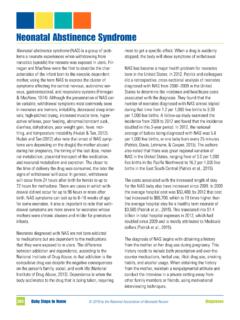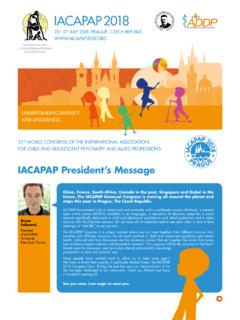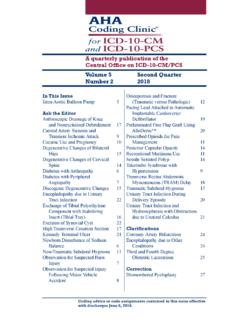Transcription of Intraventricular Hemorrhage and Periventricular …
1 Diagnoses247 Baby Steps to Home 2018 by the national association of Neonatal NursesIntraventricular Hemorrhage and Periventricular LeukomalaciaIntraventricular HemorrhageIntraventricular Hemorrhage (IVH) is bleeding inside the lateral ventricles. Bleeding frequently occurs in areas of high arterial and capillary blood flow, which most commonly occur in the subependymal germinal matrix of the brain in preterm infants. Bleeding occurs in the first 72 hours of life for about 90% of affected infants, with at least half of affected infants experiencing bleeding in the first 24 hours (Gardner, Carter, Enzman-Hines, & Hernandez, 2016).
2 IVH is the most common type of intracranial Hemorrhage present in factors for IVH are prematurity and hypoxic events. Any event that results in hypoxia, alteration of cerebral blood flow, or intravascular pressure increases the risk of an infant developing IVH (Robinson, 2012). IVH also is associated with perinatal asphyxia, low Apgar scores, low birth weight, respiratory distress requiring mechanical ventilation, rapid volume expansion, and pneumothorax. Depending on the degree of bleeding, infants with IVH may present with a range of symptoms.
3 Some infants will not have a noticeable change in clinical condition; others will present with sudden deterioration or shock-like extent of the bleed in the ventricles and brain will predict what future complications may occur. Bleeding may be confined to the germinal matrix or may enter the ventricular system. When blood enters the ventricular system, it can cause the ventricles to dilate due to increased are different grades assigned to IVH based on their severity. These include grade I (slight) isolated germinal matrix Hemorrhage grade II (small) IVH with normal ventricular size grade III (moderate) IVH with acute ventricular dilation grade IV (severe) both Intraventricular and brain parenchyma diagnosis of IVH is determined via cranial ultrasound.
4 For monitoring of an extensive bleed, serial ultrasounds may be LeukomalaciaPeriventricular leukomalacia (PVL) refers to necrosis of white matter in the brain that occurs in a characteristic pattern. PVL is believed to be the long-term outcome of ischemia and injury to the fragile cerebral white matter in the premature infant. PVL can be caused by systemic hypotension, cerebral infarction and ischemia, and episodes of apnea and bradycardia (de Vries, 2015).Additional complications that may arise from PVL depend on the size of the initial lesion and how much time has passed since the injury first occurred.
5 Clinically, at about 6 10 weeks of age, an infant with PVL will present with irritability, hypertonicity, frequent tremors, and may have an abnormal Moro reflex. Diagnosis is made via cranial ultrasound, computed tomography scan, or magnetic resonance imaging. The long-term outcome of an infant with PVL may include spastic diplegia, motor deficits, intellectual deficits, visual impairments, upper arm involvement, and lower limb weakness. Neonates who are born at younger than 30 weeks should be screened with cranial ultrasound at 7 14 days of age.
6 Many units will rescreen again at 36 40 weeks of age to determine if PVL is present. To help prevent IVH and PVL in the premature infant, care must be taken to avoid events that create swings in arterial and venous pressures. The immature neonatal brain does not have mature autoregulation of cerebral Diagnoses248 Baby Steps to Home 2018 by the national association of Neonatal Nursescirculation in place to compensate for changes in blood pressure (Ballabh, 2014). Prenatal interventions such as preventing preterm delivery, maternal transport to a regional neonatal center, and prenatal glucocorticoids may help prevent interventions include delayed cord clamping, minimized handling and suctioning, synchronized and gen-tle ventilation, prompt treatment of patent ductus arteri-osus, maintaining normal O2 and CO2 levels, preventing apneic episodes and seizures, and correction of coagu-lopathies and bleeding disorders.
7 The intervention that has shown the most benefit in preventing IVH is prenatal administration of glucocorticoids (Ballabh, 2014). Treat-ment for IVH and PVL is supportive in alone will not account for all neurological deficits in the neonate with IVH. Ironically, half of prema-ture infants with IVH will be free of neurologic symptoms. Outcome will depend on the severity of the Hemorrhage . For a small Hemorrhage , neurodevelopment disability is similar to that in premature infants without hemor-rhage. For a moderate Hemorrhage , major neurodevel-opmental disability occurs in about 31% of infants; for severe Hemorrhage , especially those diagnosed with post-hemorrhagic hydrocephalus and requiring shunt placement, major neurodevelopmental disability occurs in 80% 92% of infants (Ballabh, 2014).
8 Other impairments include hearing and vision impairments. Hearing impair-ment, ranging from 2% to 6%, and visual impairment, ranging from 17% to 33%, may occur in infants with severe IVH (Patel, 2016). Posthemorrhagic hydrocephalus (PHH) is a major com-plication of moderate to severe IVH and is defined as an abnormal accumulation of cerebrospinal fluid (CSF) in the brain that results in enlargement of cerebral ventri-cles. About 80% of CSF in the brain is produced by the choroid plexus within the four ventricles in the brain and the remaining 20% is produced by the brain parenchyma (Chen et al.)
9 , 2017). CSF circulates to bathe the brain and spinal cord and is reabsorbed by the arachnoid granu-lations, or villi, within the subarachnoid space. In PHH, there are several mechanisms that result in PHH. Large blood clots can form and block the cerebral aqueducts and fourth ventricle outlet, resulting in ventricular dilata-tion. Small blood clots can enter the ventricular system and block the arachnoid villi, thereby reducing absorption of CSF and resulting in hydrocephalus (Chen et al., 2017). In the presence of a large bleed, lysis of the red blood cells causes the release of hemoglobin and iron.
10 Both can lead to hydrocephalus (Chen et al., 2017). Currently, there is no effective means available to prevent PHH. Long-term outcomes for infants with PHH who require shunts may include neurocognitive impairment, motor dysfunction, and growth impairment. Medical management to treat PHH has shown little suc-cess, and most infants will require surgical interven-tion. Serial lumbar punctures to remove CSF and prevent shunt placement is no longer recommended because it failed to reduce disability or the need for a shunt and Cross-section view of brain: Grades of Intraventricular Hemorrhage Normal ventricleGrade IGrade IIIG rade IIGrade IVCross-section view of brain: Grades of Intraventricular Baby Steps to Home 2018 by the national association of Neonatal Nurseswas associated with an increased risk of infection (Ellen-bogan, Waqar, & Pettorini, 2016).







